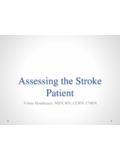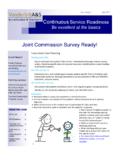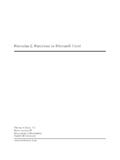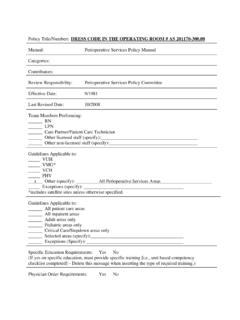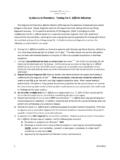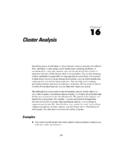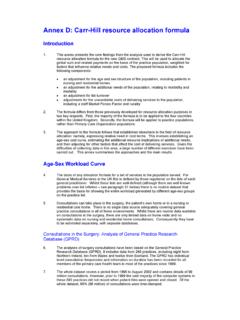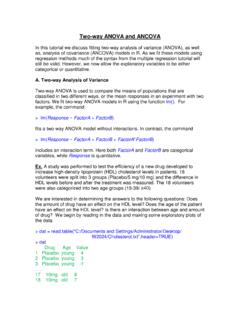Transcription of How To Use Propensity Score Analysis - …
1 How To Use Propensity Score Analysis Lisa Kaltenbach, MS. Department of Biostatistics April 11, 2008. Outline Background/Motivation Propensity Score Estimation Propensity Score Matching Regression Adjustment/Stratification Example Code/ Analysis Conclusions References Motivational Ancedote Two heart surgeons walk into a room. The first surgeon says, Man, I just finished my 100th heart surgery! . The second surgeon replies, Oh yeah, I finished my 100th heart surgery last week. I bet I'm a better surgeon than you. How many of your patients died within 3 months of surgery?
2 Only 10. of my patients died.. First surgeon smugly responds, Only 5 of mine died, so I must be the better surgeon.. Second surgeon says, My patients were probably older and had a higher risk than your patients.. Comparing apples to oranges? There may be important differences in patient characteristics between treatment groups. Want to show difference in outcome is attributable to difference in treatment (or patient condition) and not due to comparing apples to oranges. Nonrandomized comparisons give rise to apples-and-oranges scepticism.
3 Sometimes it is infeasible or unethical to assign patients to different treatments. Purpose of Propensity Scores Can produce apples-to-apples comparison under some nonrandomized conditions. Provides a way to summarize covariate information about treatment selection into a scalar value. Can be used to adjust for differences via study design (matching) or during estimation of treatment effect (stratification/regression). Analysis limitations: <10 events/variable (EPV), estimated regression coefficients may be biases & SE's may be incorrect (Peduzzi et al, 1996; Harrell et al, 1985).
4 Number of publications 100. 150. 200. 250. 0. 50. 19. 83. 19. 85. 19. 87. 19. 89. 19. 91. 19. 93. 19. Year 95. 19. 97. 19. 99. 20. 01. 20. 03. Publications in Pub Med with phrase " Propensity Score ". 20. 05. 20. 07. Notation/Definition Treatment Groups (E): Let E+ denote group with exposure. Let E- denote group without exposure. Disease Outcome (D): Let D+ denote group with disease outcome. Let D- denote group without disease outcome. Propensity Score (PS): For an individual is the conditional probability of being treated given the individual covariates.
5 PS = Estimated Pr(E+| covariates). Propensity Score Estimation Identify potential confounders. Current convention: If uncertain whether a covariate is a confounder, include it. Model E+ (typically dichotomous) as a function of covariates using entire cohort: E+ is outcome for Propensity Score estimation. Do not include D+. Logistic regression typically used. Propensity Score = estimated Pr(E+| covariates). Can use PS as a continuous variable or create quantiles. Natural Question Why estimate Pr(E+| covariates) when we already know E+?
6 Adjusting observed E+ with probability of E+. ( Propensity ) creates a quasi-randomized . experiment. For E+ & E- patients with same Propensity Score , can imagine that they were randomly assigned to each group. Subjects in E+/E- groups with nearly equal Propensity scores tend to have similar distributions in covariates used to estimate Propensity . A Balancing Score For a given Propensity Score , one gets unbiased estimates of average E+ effect. Can include a large number of covariates for PS. estimation. Original paper applied PS methodology to observational study comparing CABG to medical treatment, adjusting for 74 covariates in the PS.
7 Model. Want to assess adequacy of Propensity Score to adjust for effects of covariates by testing for differences in individual covariates between E+ & E- after adjusting for Propensity Score (often we stratify by Propensity Score quantiles) . Applications Matching. Regression adjustment/stratification. Weighting (each patient's contribution to regression model). Inverse-probability-of-tx-weighted see Robin et al, 2000. Standardized mortality ratio-weighted estimator see Sato et al, 2003. Propensity Score Matching Match on a single summary measure.
8 Consider study on low-dose aspirin & mortality Age is a strong confounder, but can be controlled by matching. Extending this to many factors becomes cumbersome quickly. Useful for studies with limited number of E+. patients and a larger number of E- patients and need to collect additional measures (ex., blood samples). Matching Techniques Nearest available matching on estimated Propensity Score : Select E+ subject. Find E- subject with closest Propensity Score , Repeat until all E+ subjects are matched. Easiest method in terms of computational considerations.
9 Others: Mahalanobis metric matching (uses Propensity Score & individual covariate values. Nearest available Mahalanobis metric matching w/. Propensity Score -based calipers. Matching in R. Install the Matching package by Jasjeet Sekhon. Match(): performs mutlitvariate and PS. matching. MatchBalance(): provides a variety of univariate tests to determine if balance exists. Matchby(): is a wrapper for Match() function which separates the matching problem into subgroups defined by a factor. Matching in Stata Install psmatch2 package created by Edwin Leuven and Barbara Sianesi.)
10 Psmatch: implements various types of Propensity Score matching estimators. one-to-one, k-nearest neighbors, radius, kernel, local linear regression, spline, Mahalanobis. Matching in SAS. Macros created and maintained by statisticians at the Mayo Clinic. Can be downloaded for free at: cfm gmatch: Computerized matching of cases to controls using the greedy matching algorithm with a fixed number of controls per case. vmatch: Computerized matching of cases to controls using variable optimal matching. The number of controls per case is allowed to vary with only the total fixed.
